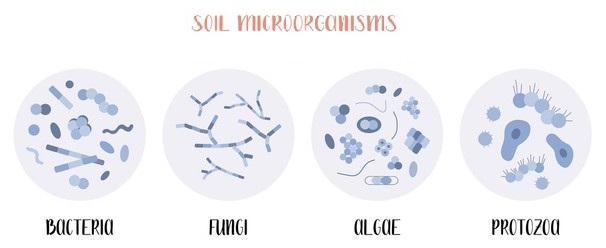Soil microbial biomass refers to the number of living microorganisms in the soil. Although it only accounts for about 1.5% of soil organic matter, it plays an important role in the cycling and transformation of soil materials and energy because it is directly or indirectly involved in almost all soil biochemical processes.

Soil microorganisms have a very important role in soil nutrient conversion and cycling, maintaining ecological balance and protecting the environment, etc. To make soil microbial biomass measurements closer to actual values, Lifeasible uses different methods to provide simultaneous measurements of soil microbial biomass changes in different ecosystems and under different utilization conditions.
| Strategy | Details | |
| Direct microscopy method | Soil samples are first made into suspensions, counted under a microscope, and the size of each type of microorganism is measured to calculate the microbial biomass contained per gram of dry soil. | |
| Colorimetric method | The colorimetric analysis is the technique normally used to determine the concentration of the analyte by comparing the color changes of the solution. This method can be used as a simple, fast, and low-cost method to determine the biomass of soil microorganisms. | |
| Fumigation series method | FI (Fumigation - incubation) method | Soil microbial biomass is calculated by measuring the amount of soil CO2 released during a certain incubation time. This method is simple to operate, with little error, and suitable for routine analysis. For most soils, the results of this method are more consistent with those of the counting method, and the results are more credible. |
| FE (Fumigation - extraction) method | FE has the following advantages compared with FI
The greatest advantage of the FE method is that it can measure microbial biomass in acidic soils, soils with large amounts of easily decomposable organic matter, and soils with waterlogged soils, and it can be combined with isotopes to study the cycle of C, N, P, and S in soils. |
|
| Substrate induction series method | The SIR (substrate-induced respiration) method | The method is simple and fast and allows estimating of the proportion of bacterial and fungal biomass in the soil. |
| Arginine-induced ammonification method | Soil microbial biomass can be estimated by measuring the NH4+-N content in the leachate. | |
| Component analysis method (ATP analysis method) | The microbial cells were first destroyed to release the contained ATP, and the leachate was extracted by appropriate extractants. The leachate was filtered, and the amount of ATP in it was determined by the fluorescein-luciferase method, and then the amount of ATP was converted to soil microbial biomass. | |
| Microbial single-cell sorting method | Lifeasible first dilutes the soil sample and then uses the microbial single cell sorter to achieve precise separation of microbial single cells in complex soil samples one by one. | |
Lifeasible has always been committed to excellence in providing our customers with services to determine soil microbial biomass variation in different ecological environments. If you are interested in our services or have any questions, please feel free to contact our staff for more information.
Lifeasible has established a one-stop service platform for plants. In addition to obtaining customized solutions for plant genetic engineering, customers can also conduct follow-up analysis and research on plants through our analysis platform. The analytical services we provide include but are not limited to the following:
Get Latest Lifeasible News and Updates Directly to Your Inbox
Adaptive Evolutionary Mechanism of Plants
February 28, 2025
Unraveling Cotton Development: Insights from Multi-Omics Studies
February 27, 2025